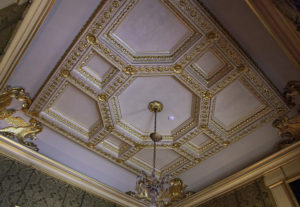Entry is into the GREAT HALL at the heart of the Palace. This is a splendid room with massive pillars supporting round topped arches. Classical statues look down from the first floor arches. The carving is by Grinling Gibbons. Opposite the main door is a splendid arch with the arms of Queen Anne proudly displayed at the top. The three standards hanging from the archway are replicas of the French standards captured at the Battle of Blenheim.
Sir James Thornhill painted the ceiling and it depicts Marlborough’s victory at the Battle of Blenheim. (Thornhill had originally been commissioned to paint the ceilings in the saloon and long library, but Sarah suspected him of over charging and employed the French artist Louis Laguerre instead.)
On either side of the main door are displays of arms and armour, along with a porters chair with its canopy and sides to keep out draughts. The brass lock on the main doors was fitted by the Fourth Duke in the C19th and is said to be a copy of the lock found on the gates of Warsaw. The key does work.
Narrow corridors with round arched ceilings run round three sides of the Great Hall. These have family portraits on the walls including the portrait of John and Sarah with their family. Unfortunately both their sons died young and their eldest daughter in the red dress, assumed the title of Second Duchess of Marlborough. On her death, her nephew became the third Duke. Along the walls are display cases containing Meissen and Sevres porcelain and Fou Kien blanc de chine.
The stairs to the first floor apartments are hidden in the corridor to the left of the main door. They lead to the “Untold Story Exhibition”:http://wasleys.org.uk/eleanor/stately_homes_castles/england/westmidlands/blenheim/blenheim_seven/index.html
The state rooms run along the south side of the central block of the Palace, forming a continuous run of rooms opening into each other.
Over the years, no money was spared in the design and furnishing of the apartments. They have a wonderful collection of Louis XIV furniture, Belgium tapestries and portraits by some of the leading artists of the time including Van Dyke, Reynolds, Romney, Kneller, Sargent….
As its name suggests, the GREEN DRAWING ROOM has green wall hangings and upholstery. On the walls are family portraits and there is a wonderful crystal chandelier. The ceiling was the work of Nicholas Hawksmoor. The gilding was added by the Fourth Duke and the gilded family crests in the corners were added by the Ninth Duke.
Beyond is the RED DRAWING ROOM with a lot of family portraits, many by renowned artists. On the pillars between the windows are large mirrors, called pier glass. These were designed to throw light back into the room. The ceiling is again by Hawksmoor with corner additions by the Ninth Duke.
As well as more family portraits, the GREEN WRITING ROOM has two large tapestries hanging on the walls. On the left is the famous tapestry showing Marlborough accepting Marshall Tallard’s surrender after the Battle of Blenheim. On the right is a tapestry depicting another stage of his campaign. This is a very comfortable room with two splendid clocks next to the doors and more pier glass. The ceiling is again the work of Hawksmoor and considered to be his finest ceiling.
The salon or drawing room was originally the main reception room but is now the STATE DINING ROOM used by the family every Christmas. The table can seat up to forty people when fully extended. It is laid with Minton China, Georgian silver and Victorian silver gilt. The Silver table piece standing on side table was commissioned by the Sixth Duke from Robert Garrard in 1845. It shows Marlborough on horseback writing the famous dispatch after the Battle of Blenheim, on a drum held by his aide Colonel Parke.
The four doorways were designed by Hawksmoor and the west marble archway was carved by Grinling Gibbons before he was dismissed by Sarah. The two headed eagle crest above the door was conferred on Marlborough by the Emperor Leopold, as a Prince of the Holy Roman Empire.
The wall murals and the ceiling are the work of the French artist, Louis Laguerre after Sarah fell out with Sir James Thornhill. The walls are cleverly designed to look as if spectators are looking down into the salon.
All my pictures are “here.”:http://wasleys.org.uk/eleanor/stately_homes_castles/england/westmidlands/blenheim/index.html










